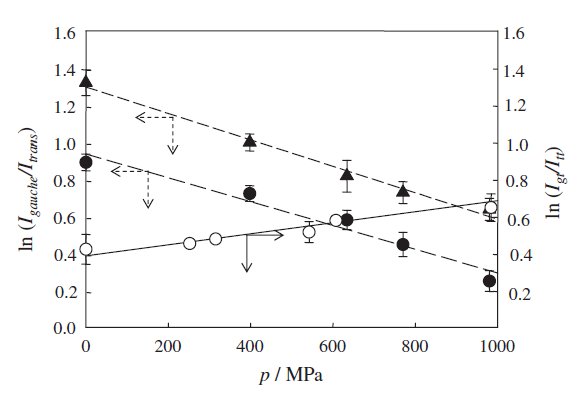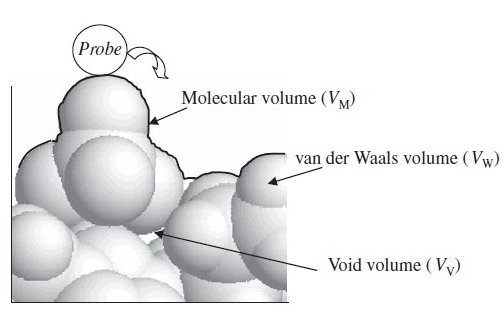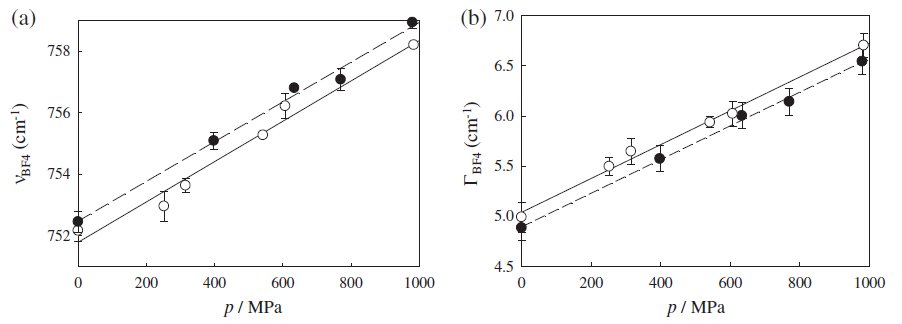|
 |
Fig. 1 |
|
|
Fig. 2 Raman spectra of pure (a) [emim][BF4] and (b) [bmim][BF4] in the region from 290 to 900 cm-1. The ‘CH2(N) b’ and ‘CH2 r’ represent the CH2(N) bending and CH2 rocking modes, respectively. The ‘BF4- str’ and ‘BF4- sc’ represent the BF4- stretching and scissoring modes, respectively. |
 |
Fig. 3. Raman spectral changes of pure (a) [emim][BF4] and (b) [bmim][BF4] as a function of pressure. |
 |
Fig. 4. Intensity fractions of the conformers of (a) [emim][BF4] and (b) [bmim][BF4] as a function of pressure. The open and closed circles in (a) represent the gauche (I430) and trans (I448) conformers of [emim]+. The open and closed triangles in (a) represent the gauche (I387) and trans (I448) conformers of [emim]+. The open and closed circles in (b) represent the gt and tt conformers of [bmim]+. The open and closed triangles in (b) represent the gauche and trans conformers of [bmim]+. The straight lines represent the results of the least-squares fit. |
 |
Fig. 5. Pressure dependences of the intensity ratio between the conformers of [emim][BF4](O: I430/I448 and O: I387/I448) and [bmim][BF4](s).The straight lines represent the results of the least-squares fit. |
 |
Fig. 6. Definitions of the volume contributions. |
 |
Fig. 7. Raman BF4- stretching spectra of pure (a) [emim][BF4] and (b) [bmim][BF4] as a function of pressure. |
 |
Fig. 8. Changes in the BF4- stretching (GBF4) frequencies and the band widths (GBF4) of [emim][BF4](d) and [bmim][BF4](s) as a function of pressure. The straight lines represent the results of the least-squares fit. |
References
[2] K. Ishii, Y. Kobayashi, K. Sakai, H. Nakayama, J. Phys. Chem. B 110 (2006) 24827.
[3] G. Kavitha, C. Narayama, J. Phys. Chem. B 111 (2007) 7003.
[4] Y. Taniguchi, J. Mol. Struct. 126 (1985) 241.
[5] H. Hamaguchi, R. Ozawa, Adv. Chem. Phys. 131 (2005) 85.
[6] H. Katayanagi, S. Hayashi, H. Hamaguchi, K. Nishikawa, Chem. Phys. Lett. 392 (2004) 460.
[7] M. Imanari, M. Nakakoshi, H. Seki, K. Nishikawa, Chem. Phys. Lett. 459 (2008) 89.
[8] R.W. Berg, Monatshefte f}ur Chemie 138 (2007) 1045.
[9] R.W. Berg, Ionic Liquids in Chemical Analysis, Analytical Chemistry, in: M. Koel (Ed.), CRC Press, LLC, 2009, pp. 307.354.
[10] Y. Umebayashi, T. Fujimori, T. Sukizaki, M. Asada, K. Fujii, R. Kanzaki, S. Ishiguro, J. Phys. Chem. A 109 (2005) 8976.
[11] R. Ozawa, S. Hayashi, S. Saha, A. Kobayashi, H. Hamaguchi, Chem. Lett. 32 (2003) 948.
[12] N.E. Heimer, R.E. Del Sesto, Z. Meng, J.S. Wilkes, W.R. Carper, J. Mol. Liquids 124 (2006) 84.
[13] R. Holomb, A. Martinelli, I. Albinsson, J.C. Lassegues, P. Johansson, P. Jaccobsson, J. Raman Spectrosco. 39 (2008) 793.
[14] J.N.A.C. Lopes, A.A.H. Padua, J. Phys. Chem. B 110 (2006) 3330.
[15] L. Su, L. Li, Y. Hu, C. Yuan, C. Shao, S. Hong, J. Chem. Phys. 130 (2009) 184503.
[16] L. Su, M. Li, X. Zhu, Z. Wang, Z. Chen, F. Li, Q. Zho, S. Hong, J. Phys. Chem. B 114 (2010) 5061.
[17] T. Takekiyo, Y. Imai, N. Hatano, H. Abe, Y. Yoshimura, High Press. Res. 31 (2011) 35.
[18] H. Shimizu, N. Miyahara, Chem. Phys. Lett. 110 (1984) 615.
[19] S. Ikawa, E. Whalley, J. Chem. Phys. 81 (1984) 1620.
[20] G. Kavitha, C. Narayana, J. Phys. Chem. B 111 (2007) 14130.
[21] H.K. Mao, P.M. Bell, J.W. Shaner, D.J. Steinberg, J. Appl. Phys. 49 (1978) 3276.
[22] GRAMS/386 user’s guide, Galacteric Industries Co., New Hampshire, p.170.
[23] Y. Imai, T. Takekiyo, H. Abe, Y. Yoshimura, High Press. Res. 31 (2011) 53.
[24] H.C. Chang, C.Y. Chang, J.C. Su, W.C. Chu, J.C. Jiang, S.H. Lin, Int. J. Mol. Sci. 7 (2006) 417.
[25] H.C. Chang, J.C. Jiang, J.C. Su, C.Y. Chang, S.H. Lin, J. Phys. Chem. A 111 (2007) 9201.
[26] Y. Taniguchi, H. Takaya, P.T.T. Wong, E. Whalley, J. Chem. Phys. 75 (1981) 4815.
[27] T. Takekiyo, T. Imai, M. Kato, Y. Taniguchi, Biochim. Biophys. Acta 1764 (2006) 355.
[28] Y. Umebayashi, S. Ishiguro, J. Chem. Soc. Faraday Trans 93 (1997) 2167.
[29] M. Kato, Y. Taniguchi, J. Chem. Phys. 93 (1990) 4345.
[30] T. Takekiyo, Y. Yoshimura, J. Phys. Chem. A 110 (2006) 10829.
[31] T. Goto, T. Takekiyo, Y. Yoshimura, J. Phys. Conf. Ser. 121 (2008) 042005.
[32] P.E. Schoen, R.G. Proest, J.P. Sheridan, J.M. Schnur, J. Chem. Phys. 71 (1979) 317.
[33] M. Kato, Y. Taniguchi, J. Chem. Phys. 96 (1991) 4440.
[34] G. Kavitha, C. Narayana, J. Phys. Chem. B 110 (2006) 8777.
[35] P.T.T. Wong, H. Mantch, R.G. Snyder, J. Chem. Phys. 79 (1983) 2369.
[36] R. Kanzaki et al., J. Mol. Liquids 147 (2009) 77.
[37] S. Seki et al., J. Mol. Liquids 152 (2010) 9.
[38] W. Kauzmann, Adv. Protein Chem. 14 (1959) 1.
[39] T.V. Chalikian, K.J. Breslauer, Biopolymers 39 (1996) 619.
[40] J. Liang, H. Edelsbrunner, P. Fu, P.V. Sudlhakar, S. Subramaniam, Proteins 33 (1998) 1.
[41] T. Imai, T. Takekiyo, A. Kovalenko, F. Hirata, M. Kato, Y. Taniguchi, Biopolymers 79 (2006) 97.
[42] T. Takekiyo, N. Hatano, H. Abe, Y. Yoshimura, in preparation.
Last Modified: April 1, 2011
